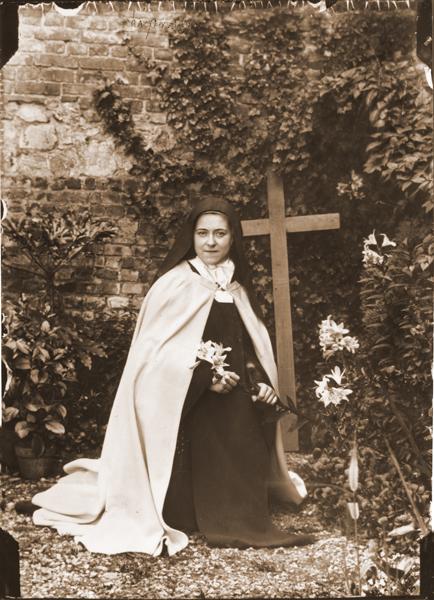
Photo Credit: Celine Martin http://www.archives-carmel-lisieux.fr/english/carmel/index.php/47-photos-english/673-photo-38-saint-therese-of-lisieux#fwgallerytop
St. Therese of Lisieux
VOX Catholic Center blog takes a look at this popular saint.
St. Therese of Lisieux. However we feel about this young Saint, it would be an unusual case for us as Catholics to know absolutely nothing about her. Even non-Catholics have heard her name. Googling her name, “therese of lisieux,” brings up approximately 536,000 hits in less than a second, and not all the websites are Catholic. She has her own, extensive Wikipedia page. Searching the same phrase on Amazon.com yields 2,447 products. However, even through all the hype, it can be easy to underestimate Therese.
Therese Martin was born to a close, loving family at the beginning of 1873. She was an affectionate child and overly sensitive because of her mother’s death that occurred when she was only four. This sensitivity was healed by God when she was fourteen, and a year later she became “a prisoner at the age of fifteen,” as she herself put it in her autobiography; this referred to her early entrance to the Discalced Carmelite convent in Lisieux, France. She died in 1897 at twenty-four years old after suffering from tuberculosis. It was said that she died from love. Her life, though short, was enough time for her to pen many letters as well as an autobiography in three manuscripts. It is her autobiography that is the most renowned of her writings because it, more than anything else, imparts the wisdom of her spirituality, called the “Little Way.”
The Little Way is, at its heart, a way of Love. Therese herself said that fear made her recoil, but that love caused her to fly down the pathway of holiness. (2) Even if we have trouble with Therese’s reputation at times, her Little Way isn’t meaningless. Read her autobiography and you’ll find that even though the language can be somewhat baroque, there are firm supports bracing it up. Therese’s writings have the approval of the Church, as she was named a Doctor of the Church, one of the only women saints to be privileged with this title.
To learn more about St. Therese, three books are highly recommended by the author of this article: First, Therese’s autobiography, The Story of a Soul. If you choose to read only one out of this short list, read this one. The second book, Fr. Michael Gaitley’s 33 Days to Merciful Love, is also profitable to read. Fr. Gaitley tells the story of Divine Mercy in an unprecedented connection to St. Therese, and even if you don’t do the Divine Mercy Consecration (though it’s highly recommended!), simply reading the book is still advised. The third book is actually a two-volume series; Therese’s Letters, edited by the same person who translated Therese’s autobiography: John Clarke, O.C.D. The series is collection of letters both received by and sent from Therese.
St. Therese’s autobiography and her Letters can be found on the Carmel website. (Note: the autobiography is under the heading “The manuscripts.”)
St. Therese of Lisieux, pray for us!
